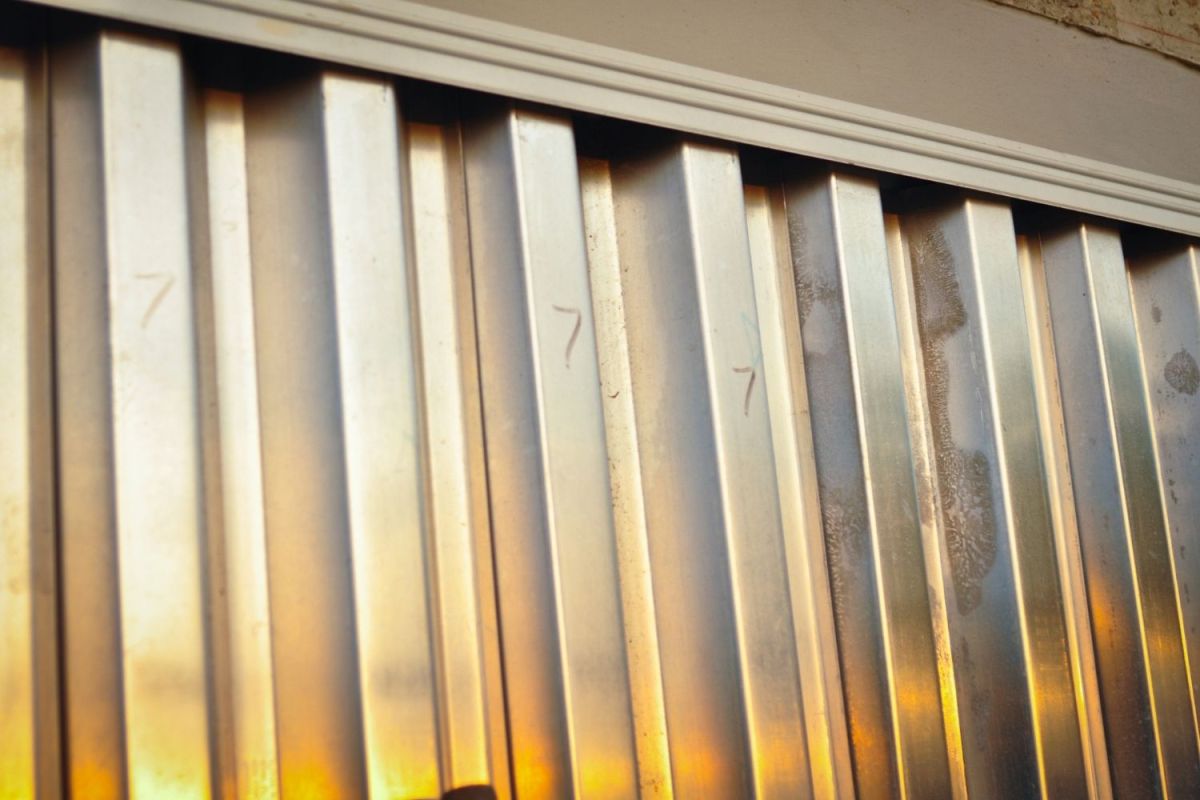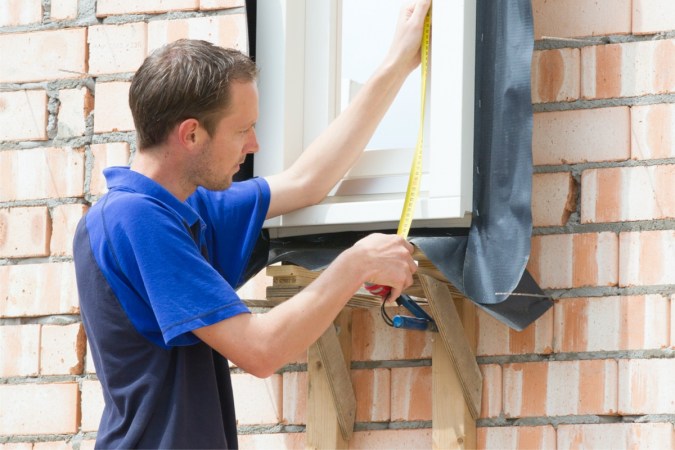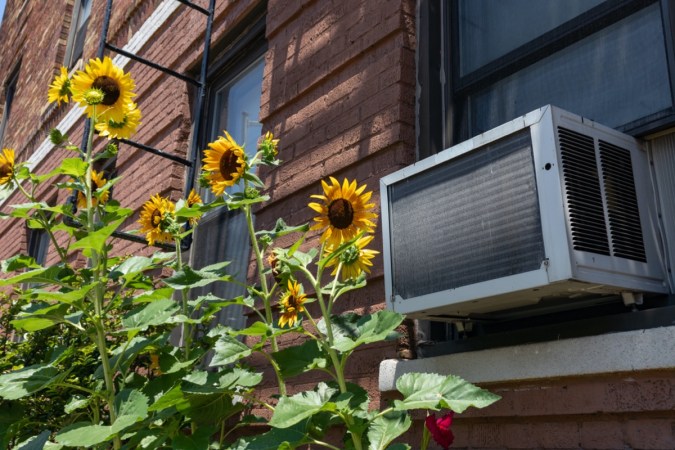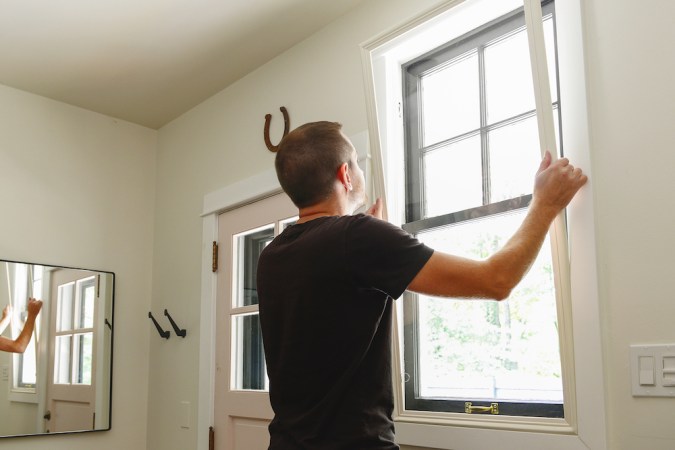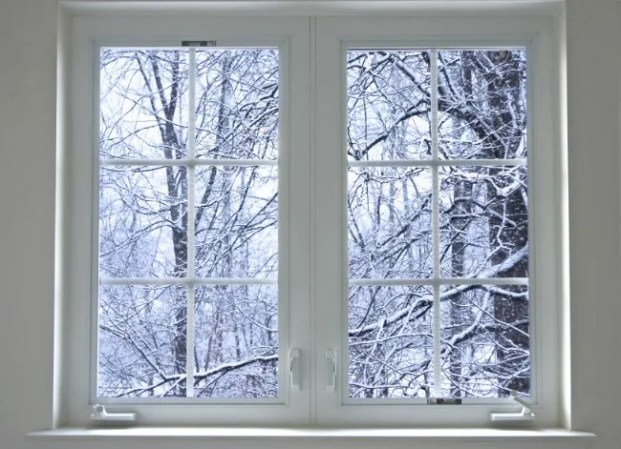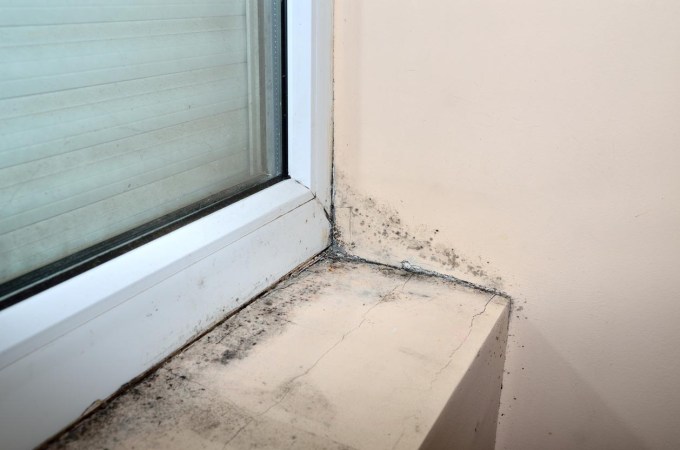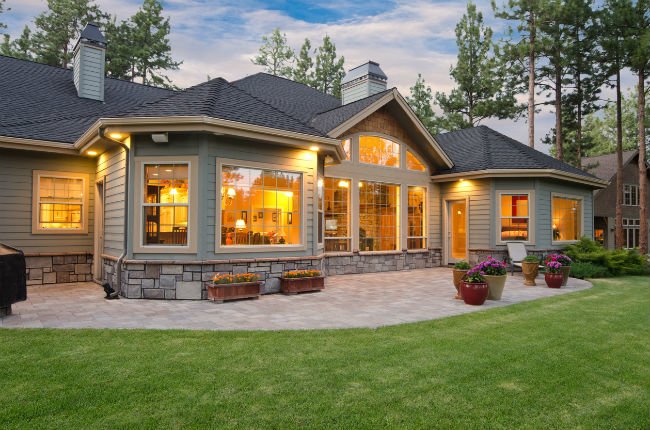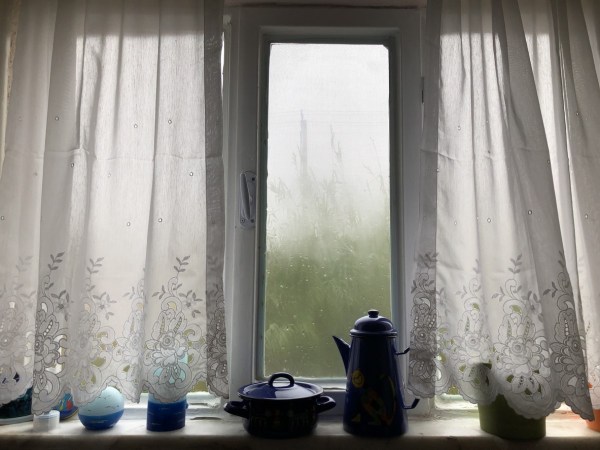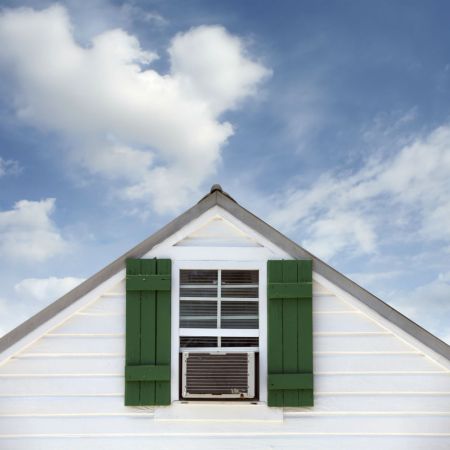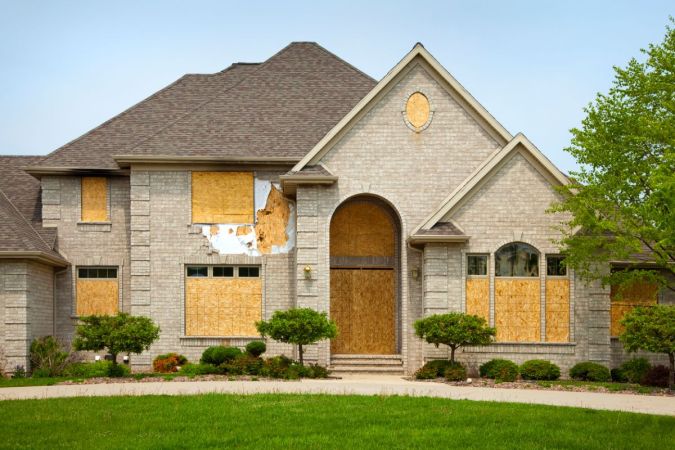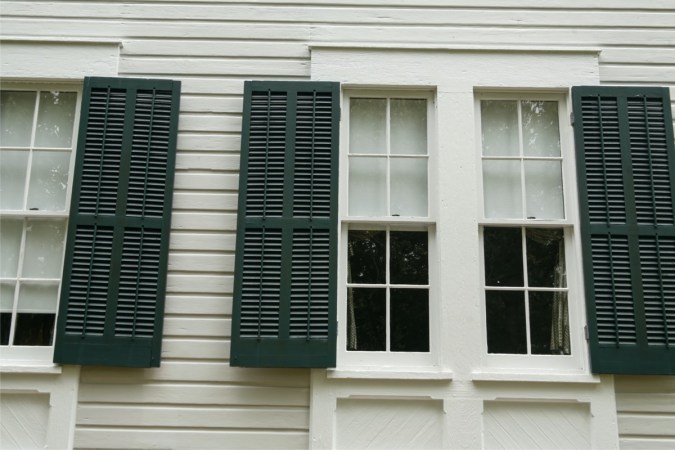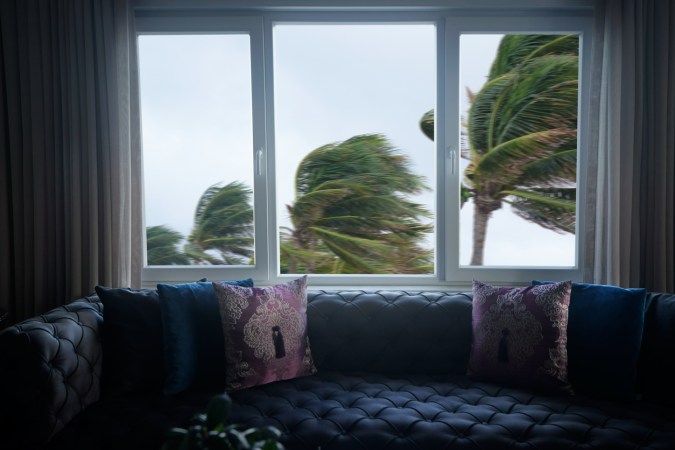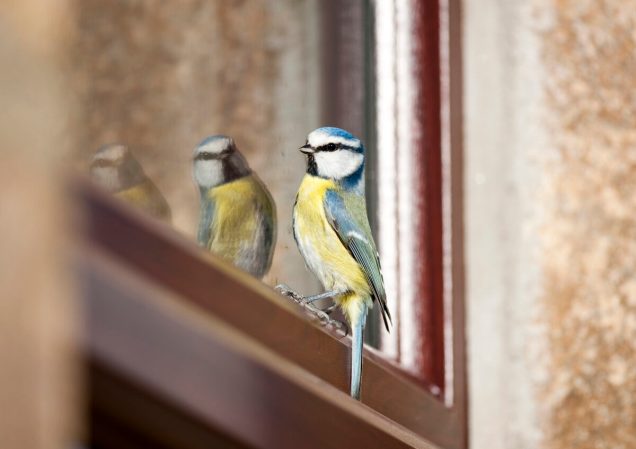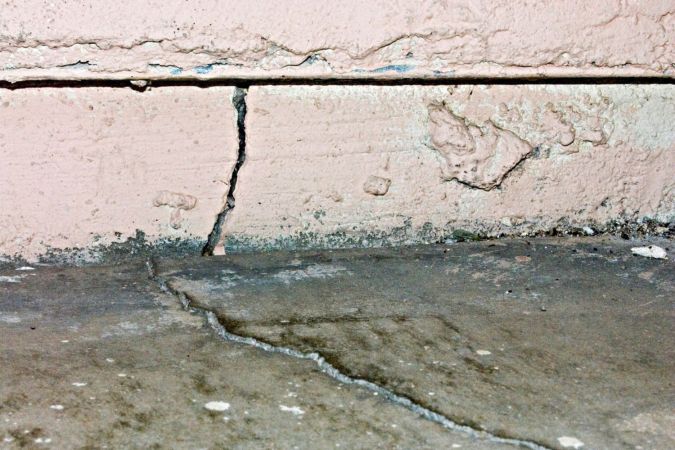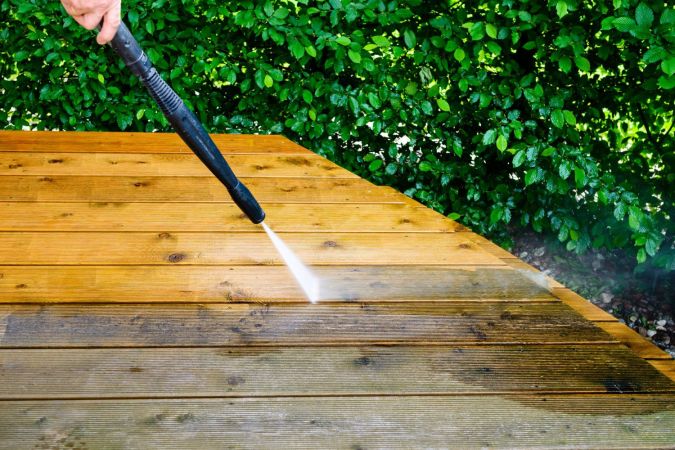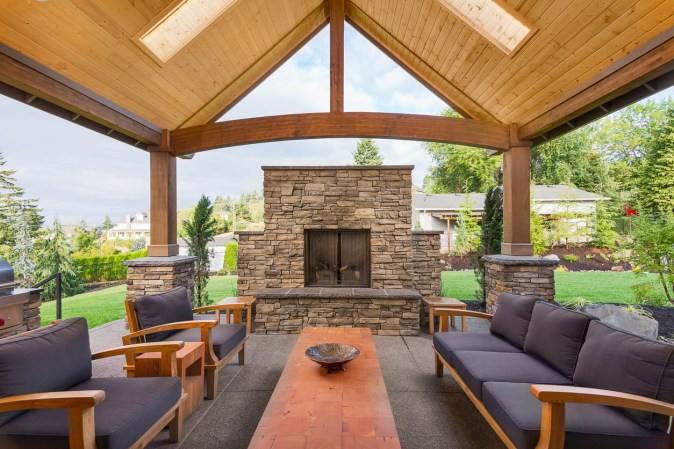We may earn revenue from the products available on this page and participate in affiliate programs. Learn More ›
- Typical Range: $1,950 to $6,094
- National Average: $4,022
Hurricane season is a yearly concern for many people living along the southeastern and eastern coasts of the U.S. While there’s nothing homeowners can do to avoid hurricanes in these regions, they can learn how to prepare for hurricanes by protecting their property—and in some states, protection measures are mandatory. Using hurricane shutters to protect windows and glass doors helps prevent damage from flying objects when the area is experiencing strong gales. According to Angi and HomeAdvisor, hurricane shutters cost between $1,950 and $6,094, with an average cost of $4,022. Homeowners can choose from among several materials to protect their windows, but they’ll need to verify that they are correctly rated for hurricanes. The cost to install hurricane shutters is primarily driven by labor, materials, and the size and number of windows that need to be covered.
Impact Windows vs. Hurricane Shutters
Homeowners aren’t limited to only using hurricane shutters to protect their homes from strong storms; another option is to install impact windows. Homeowners who are concerned with their home’s aesthetics might want to consider impact windows instead. Impact windows are built from tempered glass, which is stronger than regular glass, and come with two panes for extra protection.
Impact windows include a layer of clear plastic or resin laminate between the two glass panes to help prevent the glass from shattering when it’s hit by debris. These windows use the same kind of glass that’s used for car windshields, which is designed to avoid breaking into shards on impact. Since these windows are stronger than regular windows, they have a higher price tag as well. Homeowners can expect to pay an average of $6,510 to install impact windows, which is almost double the average cost of hurricane shutters.
Homeowners who prefer a lower-cost option will find that installing hurricane shutters is the better alternative. These temporary or permanent fixtures are designed to protect the windows and will deflect wind, rain, and debris. If homeowners choose a permanent fixture, they can select a color that suits their house so it blends in rather than stands out. Hurricane shutter costs vary based on the kind of material used. From accordion and rolling shutters to Bahama shutters, the windows will be protected from damage thanks to durable metal, aluminum, or plastic shutters that are built to withstand heavy damage. The average cost of hurricane shutters is $4,022.
Factors in Calculating Hurricane Shutters Cost
Nobody likes to think about the possibility of a disaster, but preparing for emergencies can give homeowners great peace of mind. Getting hurricane shutters installed is an excellent idea to keep residents safe and prevent homeowners from having to replace broken windows with every storm that blows through. The type of materials used also influences the price. Here are some of the top factors for homeowners to keep in mind when asking the question, “How much do hurricane shutters cost?”
Labor and Permits
Labor rates to install hurricane shutters can vary by location and material, but they range between $45 and $100 per hour on average. Most hurricane-affected states require permits to install storm shutters. If applicable, homeowners may also need approval from their HOA (homeowners association) to make sure the shutters meet neighborhood requirements. Most permits range between $50 and $200.
Materials
Homeowners can choose from several materials to protect their windows from storm damage: wood, metal, fabric, aluminum, or plastic. Plywood is the least expensive and least permanent, with a cost of $2 to $6 per square foot. From there, the prices vary between $5 and $60 per square foot, with electric roll-down metal shutters being the most expensive.
Geographic Location
While Florida is commonly a target for hurricanes due to its geographic position, many other Gulf and East Coast states are at high risk of hurricanes as well. The cost of living varies from Texas to North Carolina, so the cost of labor and materials will be different. For example, homeowners in Florida will pay a relatively high average of $4,300 for hurricane shutters. Average prices in Georgia are much lower at $1,500, and in Massachusetts hurricane shutters will cost around $2,100. Generally, hurricane shutters in large cities will cost more than they would in more rural areas.
Shutter Composition, Type, and Style
A hurricane shutter for windows can come in all shapes and sizes, which is helpful for homeowners who prefer to choose a shutter that suits their house style or offers maximum protection. Bahama, accordion, roll-up, colonial, and fabric are some of the top choices. Most of these shutters are permanent fixtures that remain in place for aesthetic purposes (like the Bahama shutters), but others can be folded away when they’re not in use or removed entirely. Permanent shutters are typically more costly than temporary options. A popular example is colonial shutters, which cost between $220 and $345 to install. Hurricane screens can be put up and taken down between seasons, and these cost significantly less at $115 to $240. For homeowners who need a particular finish or special mounting hardware, the costs will also increase. The same is true if the shutters homeowners choose require a special storm bar to be installed to ensure the shutters remain in place during a storm.
Size and Design of Windows and Doors
The cost of hurricane shutters is also driven by how many windows or doors need to be covered. On average, it takes about 1 hour to put up 7 square feet of shutters. Most shutters are 24 inches by 42 inches or 7 square feet, so it will take about an hour to install shutters on one window. For example, if a homeowner chose a Bahama shutter for $20 per square foot and installed only one, it would cost $140 for labor and materials, on average. Storm shutters for windows that are uniquely shaped may be pricier if they need to be custom built.
Installation Location
Some windows may be difficult or dangerous to access, so the location of the windows may affect the price to install hurricane shutters. For example, homeowners may pay more to shutter windows on a second or third floor than on a ground floor. For shutters on a sliding glass door, homeowners can expect to pay between $10 and $60 per square foot depending on the materials used. Accordion and roll-down styles are popular choices that still allow homeowners to access the door. Mobile homes can be especially vulnerable to hurricane damage. Any shutter option will work on a mobile home, but some popular options are plywood and sliding panels. The cost for these is generally between $2 and $20 per square foot.
Seasonality
Understandably, demand for hurricane shutters goes up significantly around the start of hurricane season and then throughout the season. As such, the cost to have hurricane shutters installed is much higher during the summer and early fall. Homeowners may or may not have the option to wait for prices to go down, but in most regions winter is the most affordable season to have hurricane shutters installed.
Additional Costs and Considerations
Installing hurricane shutters is a wise choice to protect the home against storm damage, but homeowners need to factor in all the options when budgeting for hurricane shutter costs. Depending on the home’s storage capacity and the homeowner’s preferences, permanent or temporary shutters are both an option. Custom fittings are another potential cost factor. A reduction in homeowners insurance premiums, however, may help offset some of these costs.
Permanent Shutters vs. Temporary Paneling
In many cases, it’s less expensive to install temporary paneling than to install permanent shutters. Hurricane fabric is one example. This is a temporary installation with an excellent track record for protecting windows, and homeowners can put up the fabric themselves before each storm. More permanent structures, like roll-down metal doors, remain in place year-round. They operate like a garage door, so they’re easy to get into position during storm preparations, but they are more expensive to install. “We always recommend permanent shutters as the benefits far outweigh removable shutters…which only give you hurricane protection without the other benefits of permanent shutters such as security or heat penetration,” says Thaddeus Tripodi, CEO of Brevard Shutters & Accessories. For homeowners concerned about the aesthetics of permanent shutters, there are plenty of options that provide adequate protection without compromising on looks.
Custom Fittings
Some homes have large or oddly shaped windows. These will require some customization to build a hurricane shutter that fits snugly. Customizing any construction material will always cost more, so homeowners may want to check online for “hurricane shutters near me” to find a company that can quote a custom shutter. Skylights are another feature that will require a custom fitting to make sure they’re fully protected.
Homeowners Insurance
Since insurance companies don’t want to pay more than necessary for home repairs caused by natural disasters, they often offer incentives for homeowners to protect their properties. Homeowners can talk with their homeowners insurance provider to determine how much they could save on premiums if they installed FEMA-rated hurricane shutters. It is common for these discounts to amount to between 8 and 10 percent in savings.
Maintenance
It’s important for homeowners to regularly check that their hurricane shutters are in good working order so that when they’re needed, they can protect the home effectively. Tracks that haven’t been cleaned or lubricated for a while may become stuck, so it’s important to ensure that the shutter tracks are not rusty or dirty. Homeowners can clean the tracks with soap and water and lubricate hinges themselves. Permanent shutters may also start to look dingy over time, so it’s a good idea to have them repainted every few years. It typically costs around $40 to $70 per shutter for professional painting.
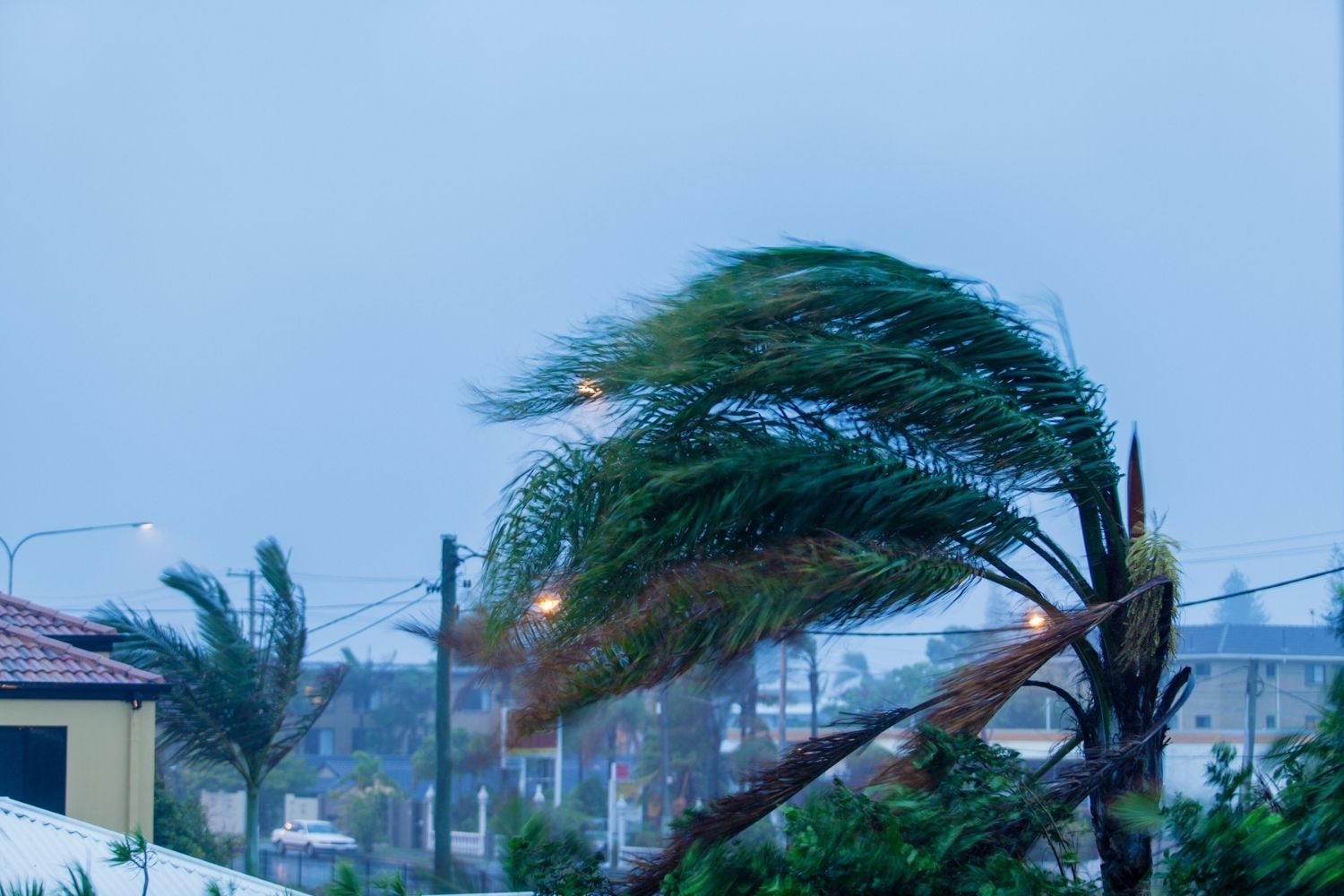
Types of Hurricane Shutters
Even though every kind of hurricane shutter has the same purpose, they each have their unique features and benefits—and drawbacks, in some cases. In order to choose the best hurricane shutters, homeowners may want to do some research or consult with a pro to make sure they install shutters that provide adequate protection, are easy to use, and suit the home’s style. Here are the top types of hurricane shutters and their associated costs.
Plywood
In many areas, homeowners use plywood to cover their windows as a temporary protection method. Even with this simple method, there are recommendations to make sure they’re effective. The plywood should be at least ⅝-inch thick, be secured with ¼-inch screws or lag bolts, and overlap the window by at least 4 inches. The materials cost $2 to $6 per square foot, making it economical if done correctly.
Fabric Screen
Fabric storm shutters are much more than just a bit of canvas tacked over the windows. They are made of thick material that’s reinforced with PVC or mesh and then coated with resin to make them even more durable and resistant to tears. Fabric hurricane shutters can be attached with grommets or slide brackets and buckles or installed in a roll-down style. Hurricane fabric costs $5 to $15 for materials and $45 to $100 per hour for installation.
Clear Polycarbonate
Another less expensive option is the clear polycarbonate style of hurricane shutters. For $10 to $15 per square foot, homeowners can choose and install a style that’s certified to protect the windows. Clear polycarbonate shutters are accordion window shutters that resist damage since their wavy surface deflects the impact of debris.
Aluminum
Aluminum is a popular choice for hurricane shutters, especially for accordion and clamshell styles. Even though aluminum is a lightweight material, it is strong enough to stand up to rain and wind. It has the added bonus of affordability, costing on average $20 to $40 per square foot.
Storm Panel
Metal storm panels are the least expensive permanent option at $10 to $20 per square foot. These hurricane panels are built to overlap each other for extra protection during a storm and are made of corrugated metal, steel, plastic, or aluminum. The tracks remain in place all year, but the metal shutters can be removed and stored to allow light into the house when not in use.
Accordion
Accordion hurricane shutters are similar to the corrugated storm panels with one difference: They fold into a box attached to the window. This type of hurricane shutter costs $15 to $30 per square foot with a labor cost of $45 to $100 per hour for every 7 square feet. The shutters will remain on the windows permanently, though they’re hidden in a box that can be painted to match the home. Accordion shutters are usually made of aluminum or plastic.
Bahama
Homeowners looking for a dual-purpose shutter might prefer Bahama hurricane shutters. These are single shutters that are raised over the window like an awning. The louvered slats provide shade from the sun, which can also cool the house from the heat all year long. When it’s time to prepare for a storm, the homeowner can simply remove the rod and secure the shutter to the bottom of the window. Bahama shutters cost between $20 and $35 per square foot before installation.
Colonial
Colonial hurricane shutters are traditional-looking shutters that add style as well as function to a home. They have the same louvered slats as traditional shutters, but they’re usually more durable than non-hurricane window shutters. During storm preparation, homeowners can fold the shutters in toward each other, then secure them to withstand the wind. Colonial shutters cost $25 to $35 on average for materials.
Roll-Up or Roll-Down
Roll-up or roll-down hurricane shutters function like a similarly styled garage door. A metal box is installed above or below the window or door, and the paneled metal or plastic door is rolled up or down as needed to protect the glass. This type of hurricane shutter can be operated manually by a crank or with an electric motor for easy use. Once they’re open, they should be bolted down to remain secure. Rolling hurricane shutters usually cost $25 to $60 per square foot in addition to installation costs. These are considered the most secure kind of storm protection.
Motorized or Electric
Homeowners could choose to install a motor to operate rolling or accordion shutters if they don’t want to, or physically can’t, prepare each window manually. On top of the labor and material costs of the preferred shutter, installing a motor on each window costs around $600.
Hurricane Screens
Hurricane screens are similar to hurricane fabric, but they’re made with PVC-coated fabric, polypropylene, or even Kevlar. This type of shutter offers durable protection to windows from storm damage. Homeowners can expect to pay $10 to $20 per square foot before installation.
Clamshell
Usually made from corrugated aluminum, clamshell shutters are relatively inconspicuous, functioning as awnings that can be folded down to shield windows in case of a storm. Clamshell awnings will typically cost $30 per square foot, or about $300 per window.
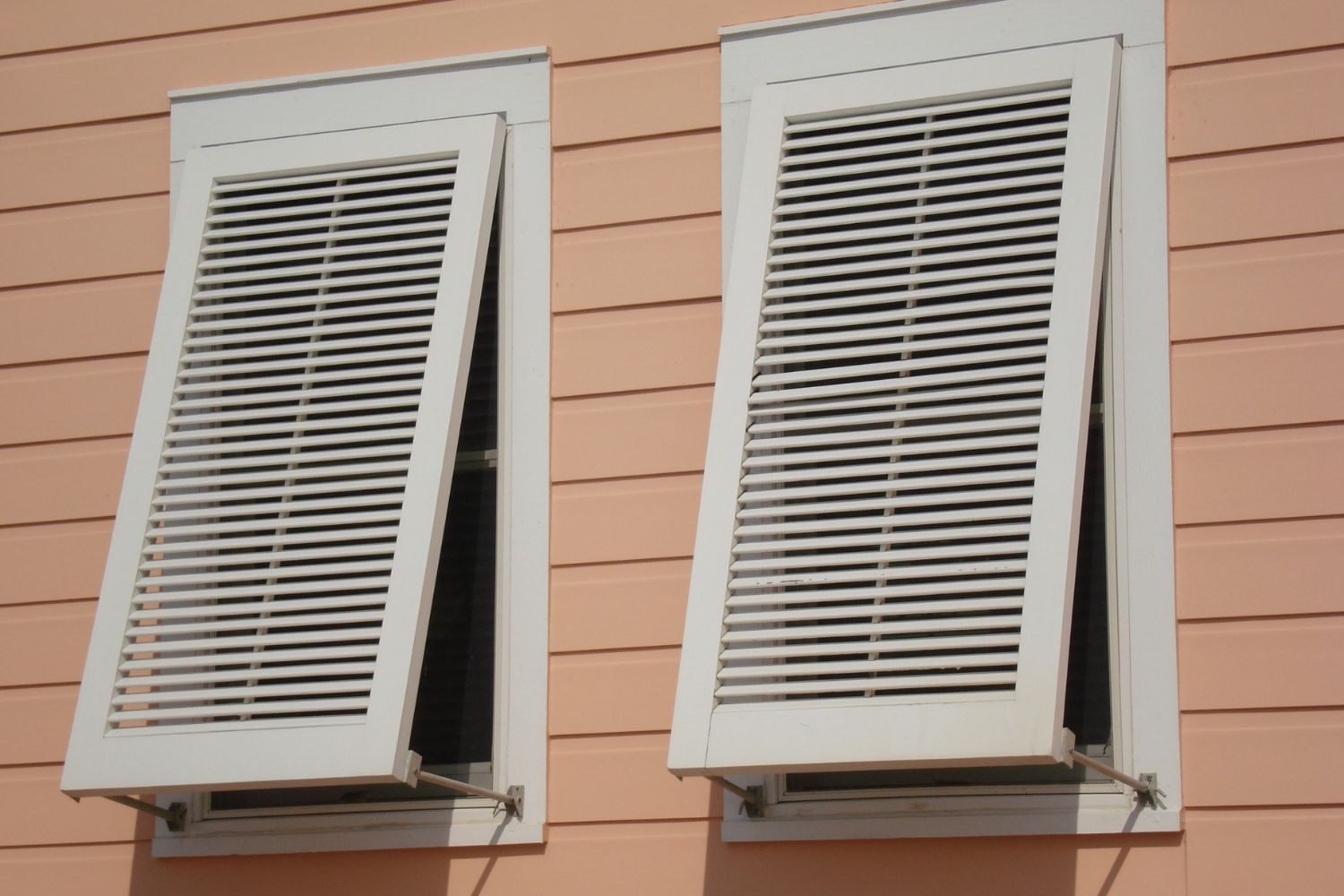
Do I Need Hurricane Shutters?
Spending the extra money on hurricane shutters can seem fruitless or excessive, but there are a few key factors to consider when researching hurricane shutters. For instance, many coastal regions require homes to have hurricane shutters by law. For homeowners who live in an area with a history of hurricanes—even infrequent ones—spending some money up front can save in the long run on much costlier window repairs. Hurricane shutters are the best way to minimize property damage from excessive winds, debris, and water. Not only can homeowners potentially get a reduction in home insurance premiums, but they’ll also generally see a 50 percent return on investment after installing adequate hurricane shutters.
Law Mandates
Many coastal areas or states have mandates regarding protection methods against storm damage. In Florida, homes built after 2001 are required to have some kind of storm protection on their windows. Homeowners can choose hurricane shutters or impact windows to meet this requirement. While these kinds of mandates can be frustrating to adhere to, they are designed to prevent excessive property damage, which can burden emergency services and local businesses who can’t keep up with demand to replace or repair damaged property.
For homeowners in North Carolina, insurance companies are required to provide premium discounts if the homeowner adds hurricane-rated shutters to their house. Homeowners can check with their local municipalities to find out what specific laws apply in their region.
History of Storms
Hurricanes can cause serious damage to a home, especially if the homeowner hasn’t made smart preparations for a major storm. Homeowners will want to research the history of hurricane storms in their region: their frequency, intensity, and average duration. According to Tripodi, “Everyone living in a wind-borne hurricane zone or high-velocity wind zone needs protection in every opening in the home or building.” Homeowners in areas that typically see one or more hurricanes per year will want to consider one of the stronger or more permanent kinds of hurricane shutters. Homeowners can quickly offset the up-front costs of hurricane shutters if they protect the home from severe damage more than once each year.
For homeowners who live in an area that sees hurricanes less than once per year, temporary hurricane shutters for windows and doors could be a realistic option. They can be installed quickly when needed but don’t affect the home’s appearance when not in use.
Previous Property Damage or Injury
Properties can sustain serious damage from a hurricane, even when they’re not located directly on the coast. Homes that are 100 miles inland could still experience strong winds and rains from a powerful hurricane that makes landfall. If the home is located within a frequent path of hurricanes, homeowners should consider adding some kind of storm protection to their windows. This is especially true for homeowners who have recently moved to a hurricane-prone region and whose home has been repaired in the past due to hurricane damage. The last thing homeowners want is to learn how dangerous broken glass is or how hard the wind blows debris and rain through a broken window during a storm. Homeowners can keep themselves and their family safe from hurricanes by doing what they can to prevent storm damage to their home, while also knowing what not to do during a hurricane.
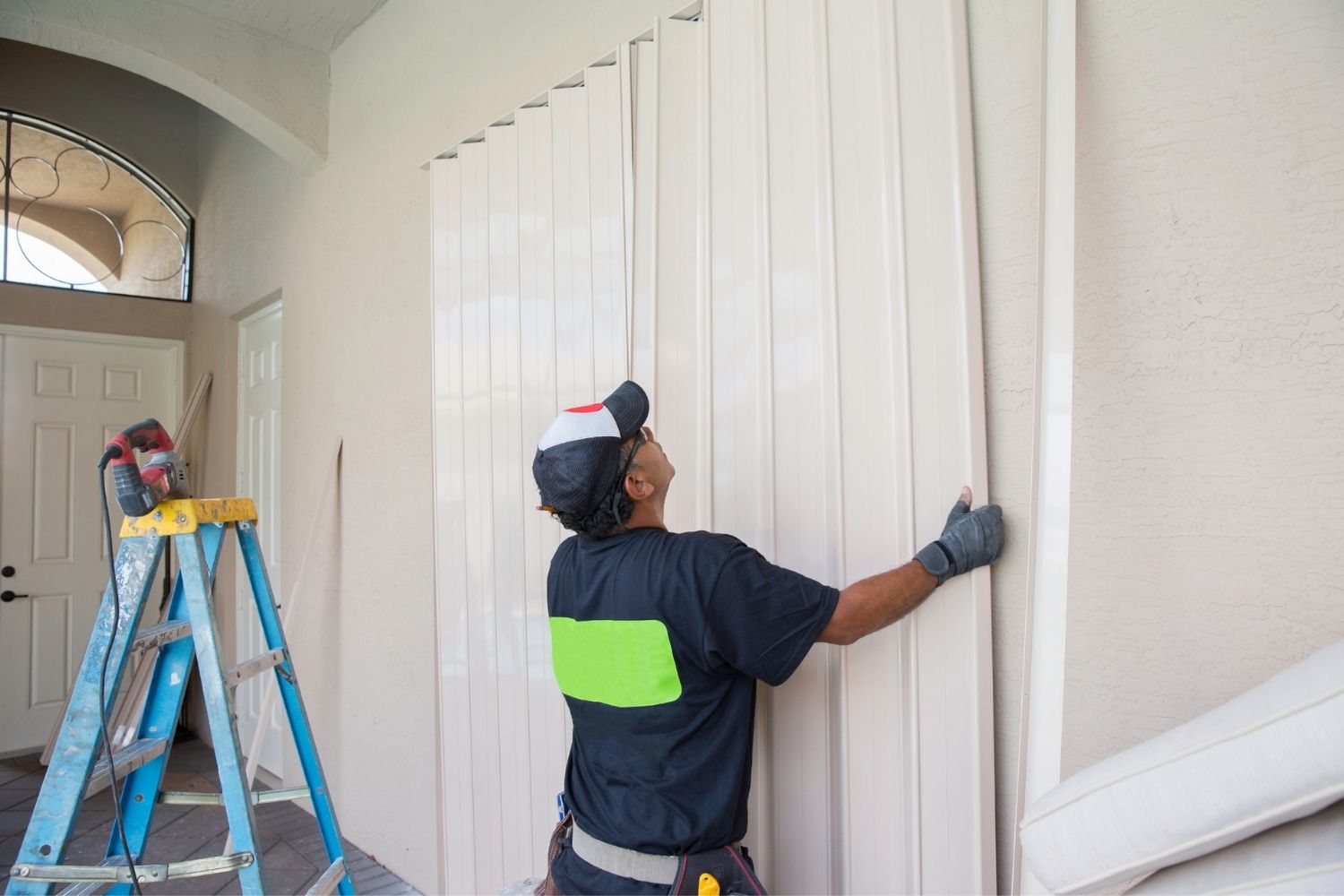
Hurricane Shutters Installation: DIY vs. Hiring a Professional
Adding extra home protection features can be an unexpected cost for some people, making them curious about DIY shutter installation. Homeowners who have the tools to attach plywood sheets to their windows and doors using lag bolts can certainly try to complete their own window protection project. But this is a temporary method that the homeowner will need to repeat frequently, and plywood can still be ripped off the windows in some cases. Homeowners can attach other types of shutters before each storm, as long as they’re adequately informed on how to secure them. Other factors such as obtaining permits and ensuring that the shutters meet FEMA standards must be considered. “When you hire a licensed shutter contractor, you get the assurance of product approval in the particular shutter being installed. All hurricane shutters need permits to assure proper installation,” Tripodi says.
In the majority of cases, it’s best to leave the installation of hurricane shutters to a pro. The last thing homeowners want is to secure a shutter improperly and have a storm rip it off, leaving them with the steep cost of window replacement. As Tripodi says, “You might save a little money [by installing yourself], but in the long run, how much did you really save if the shutter fails?” Leave the tough job to a shutter installer who will know how to work with the materials and properly install them. In some cases, hurricane shutters have to be installed per specific building codes, which means the contractor is the most qualified person to install them. Beyond that, a shutter contractor can show the homeowner how to choose storm shutters based on their house and their needs. They can point you in the direction of a type of shutter that is easy to use and won’t look out of place on the home. They’ll be able to determine some great options and offer a custom quote for each individual house.
How to Save Money on Hurricane Shutters Cost
It’s natural to want to save money on home improvement projects, but sometimes it’s better to avoid the cheapest options available, especially when it comes to safety. Hurricane shutters save homeowners money in the long run by reducing the need for repairs after storms, even if they have a high up-front cost. Nevertheless, there are a few ways to avoid having to pay excessive rates for hurricane shutters.
- Choose the right shutter for the home and the homeowner. Plywood is inexpensive, but it may not do the job. On the other hand, every window doesn’t have to have the more expensive rolling shutters. Choose the style that offers protection at the right price, even if it’s a combination of types of shutters.
- Don’t skip any windows. Homeowners might be tempted to install shutters on only the windows that face the coast to save money, but the winds can change directions, especially in the middle of the storm, and the home can be unprotected if shutters aren’t installed on every window.
- Check various insurance policies. If the homeowner’s current policy doesn’t offer a discount incentive for hurricane-rated shutters or impact windows, the homeowner may want to shop around to find one that does. The premium savings each year could add up to cover the costs of installing hurricane shutters.
- Install shutters before hurricane season. Homeowners can probably find installation discounts for installing hurricane shutters long before hurricane season hits. Requesting installation right before a storm or right after will cost more due to demand.
- Get multiple quotes. As always, homeowners should not hesitate to price shop. Contractors may have specials or offer different options that fit within their budget.
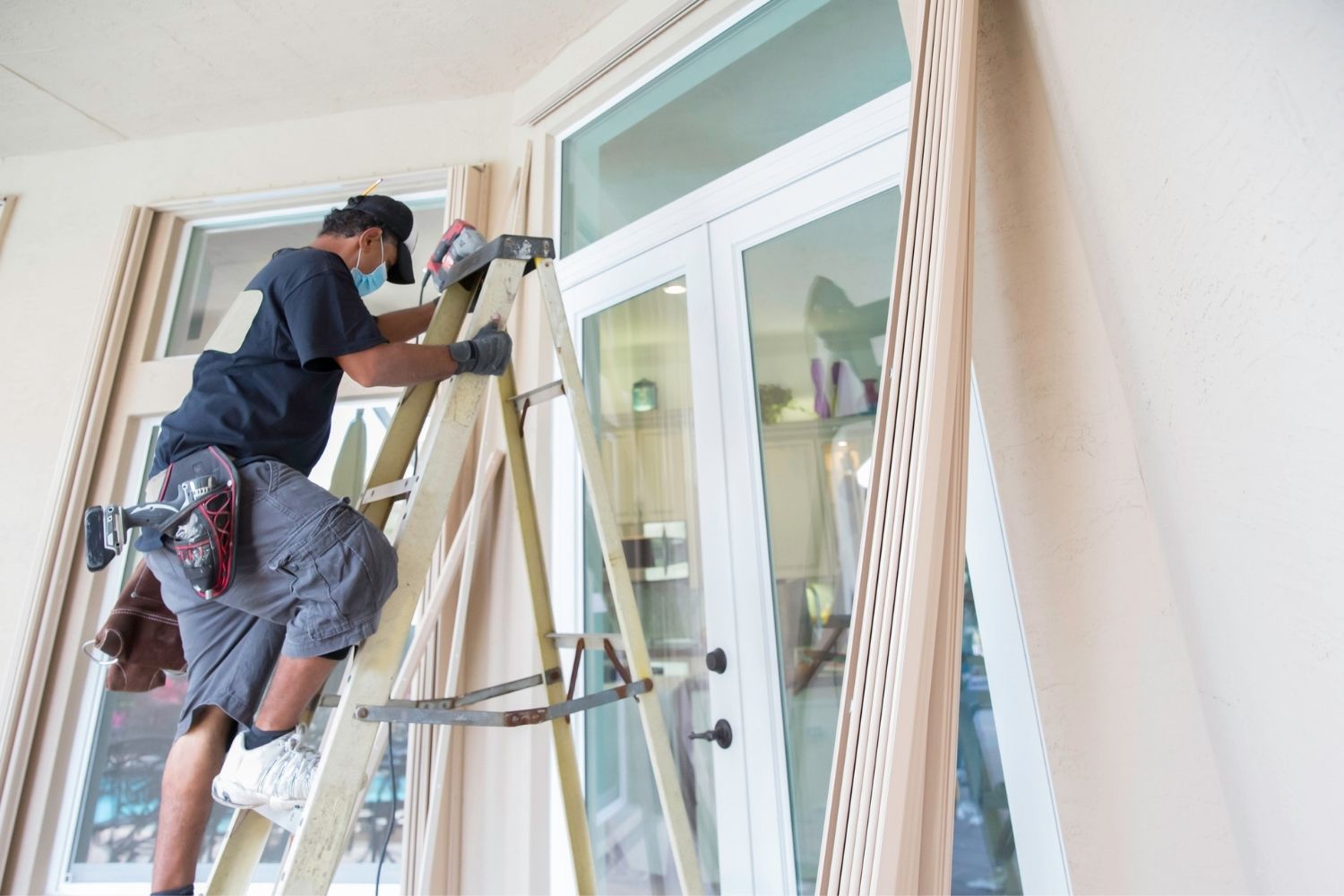
Questions to Ask About Hurricane Shutters
Since the safety of your home and family are at stake here, you want to make sure you choose the right shutters and the right installer. Be prepared for your consultation by reviewing these questions you can ask your installer about hurricane shutters.
- Are you licensed and insured?
- How long have you been in business?
- Do you have references I can contact?
- Are you familiar with local building codes for hurricane shutters?
- What types of shutters are you comfortable working with?
- What kind of shutter do you recommend for my house?
- Will I need custom-built shutters?
- What if I want to use fabric shutters on my windows but a rolling shutter on my glass doors?
- How long will it take to install the shutters?
- Do you charge by the hour or a flat rate per window?
- Do you offer any discounts or season specials?
- Are there any guarantees or warranties you offer or that are offered by the manufacturers?
- How long should these shutters last?
- How do I use them?
- What if I have a problem getting them to shut as I prepare for a storm?
- What do I need to do to maintain them?
FAQs
Before hiring a shutter contractor, homeowners should have all the information they need about hurricane shutters and their costs. Here are the answers to several of the most frequently asked questions to help guide the decision-making process.
Q. How much does it cost to install an anti-impact guard on a window?
The average cost of anti-impact guards is $5 to $12 per square foot. Since this is only a film that’s applied to the window pane to resist damage, homeowners will likely need a second layer of protection like hurricane fabric to make sure they are fully protected.
Q. What is the average cost of hurricane shutters in Florida?
The average cost to install hurricane shutters in Florida is $4,300. The exact price will vary for homes that have more windows than the average house or for more expensive materials.
Q. Do I need hurricane shutters for all of my windows?
It’s best to cover all glass windows or doors, even if the homeowner thinks they’re protected on one side of the house. Hurricanes are violent storms with winds that can change directions during the different parts of the storm.
Q. How do I measure for hurricane shutters?
It’s important to measure a bit outside of the window to account for hardware—round up an inch while measuring length and width. For horizontal panels, round up 2 inches.
Q. When should I put up my hurricane shutters?
Even a Category 1 hurricane can cause some damage to windows. Hurricane shutters should be put in place any time a hurricane watch has been put into effect. Homeowners should not wait until the storm is already brewing to begin installing new shutters.
Q. How much can hurricane shutters save me on my insurance premiums?
In many cases, homeowners can save between 8 and 10 percent on premiums when they install hurricane shutters, depending on their region.
Sources: HomeAdvisor, Fixr, Crystal Awnings and Hurricane Shutters
